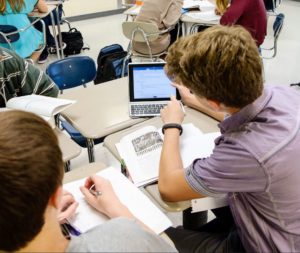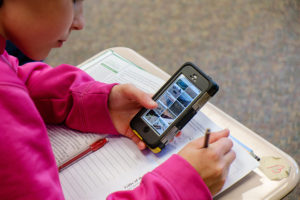A quiet revolution has been underway in K-12 education. Sparked by the promise that learning can be truly personalized, education leaders are transforming how teachers teach and students learn through technology.
 On April 25, the Maury Alliance hosted “Wiring the Classroom: Empowering Students through Technology” – a forum convening state, community, and school leaders to discuss how technology is changing teaching and learning in K-12 schools. I had the pleasure of joining Maury County leaders to discuss what the research tells us about the effect of technology on student outcomes and emerging, innovative use of technology in Tennessee schools. In short, a series of rigorous studies (these two from Johns Hopkins University on math and reading outcomes, and this one from Michigan State University) have told us that when technology is used in learning, modest, but noteworthy positive gains have been seen in student academic outcomes.
On April 25, the Maury Alliance hosted “Wiring the Classroom: Empowering Students through Technology” – a forum convening state, community, and school leaders to discuss how technology is changing teaching and learning in K-12 schools. I had the pleasure of joining Maury County leaders to discuss what the research tells us about the effect of technology on student outcomes and emerging, innovative use of technology in Tennessee schools. In short, a series of rigorous studies (these two from Johns Hopkins University on math and reading outcomes, and this one from Michigan State University) have told us that when technology is used in learning, modest, but noteworthy positive gains have been seen in student academic outcomes.
Backed by research, Maury County education leaders have begun a comprehensive 1:1 technology transition, providing every student direct access to a personal tech device to seamlessly engage in learning activities. While the Maury County Public Schools prepares its rollout plan, school leaders like Dr. Ryan Jackson at Mt. Pleasant High School are pushing the envelope on what’s possible with the resources they have now. In response to a question from the panel moderator, Dr. Jackson urged the audience to consider the nature of the modern economy, and the vastly different skills and knowledge required to succeed compared to just a generation ago.
“We are on a threshold of opportunity. The expectations for our students have radically changed. What is public education going to do to catch up?” asks Dr. Jackson, rhetorically.
All eyes were locked on the principal, including some of his own teachers in the audience. Dr. Jackson has taken a grassroots approach to cultivating tech use in his classrooms, leveraging early adopter teachers at Mt. Pleasant to spread innovative practices across the K-12 campus. These teaching strategies include empowering students to pursue research and collaborate on team-based assessments using smartphones and embedding technology in rigorous STEM project-based learning.
While the excitement about technology’s promise to alter–if not redefine—learning experiences for students can be felt in Maury County, research tells us that technology is most effective when its use is guided by a highly effective teacher who takes care to understand individual student needs. Personalized learning involves teachers using diagnostic information to guide student supports, students exercising choice and autonomy in learning activities, and use of project-based learning to encourage student collaboration and critical thinking. While these aren’t novel concepts, technology is breathing new life into the practice of personalized learning. Through technology, teachers are able to collect helpful information on individual students learning strengths and opportunities with newfound efficiency, and students are able to access curriculum at their level of competency.
On the state level, Tennessee has taken note. In December 2015, Tennessee Commissioner of Education Candice McQueen convened a diverse group of leaders to explore local and national personalized learning strategies and inform state and local pilot programs. This effort represents a state-wide approach to cultivating sound personalized learning strategies across Tennessee districts and schools.
Many schools around the state have, for several years, been leading the personalized learning charge by empowering students to use technology freely – what some educators refer to as “powering students up, instead of down.” In early April, I had the opportunity to tour STEM School Chattanooga, led by Dr. Tony Donen. STEM School Chattanooga has embraced business-industry partnerships to equip students with skills to take on real-world problems through group-based projects that harness technology. Before embarking on a new project, teachers at STEM School Chattanooga provide general framing, highlight concepts students should consider using, outline key learning objectives, and support students as they explore solutions through individual and collaborative means. Students are encouraged to explore whatever technology is available to them to conduct research, engage in communication with one another, and bring their work together into presentations. The result borders on organized chaos, with students grappling real-world problems by whatever means – small group collaboration, individual research with laptops, tablets, and smartphones – exercising creativity and critical thinking. It is a remarkable sight.
Schools like Mt. Pleasant in Maury County and STEM School Chattanooga in Hamilton County are maximizing technology-based learning for their students. At these schools and others, we are learning that the revolution begins with technology, but ultimately, it must be personalized.
